Identification Sources and High-Risk Areas of Sediment Heavy Metals in the Yellow River by Geographical Detector Method
Abstract
:1. Introduction
2. Materials and Methods
2.1. Study Area
2.2. Sample Collection and Data Measure
2.3. Factor Selection and Data Acquisition
2.4. GDM
- Nonlinearity weakness: Q(D1 ∩ D2) < MIN(Q(D1),Q(D2));
- Nonlinearity weakness for a single factor;
- MIN(Q(D1),Q(D2)) < Q(D1 ∩ D2) < MAX(Q(D1),Q(D2));
- Enhancement of nonlinearity: Q(D1 ∩ D2) > Q(D1) + Q(D2);
- Enhancement of two factors: Q(D1 ∩ D2) > MAX(Q(D1),Q(D2));
- Independence: Q(D1 ∩ D2) = Q(D1) + Q(D2).
2.5. Data Processing and Graphics Production
3. Results and Analysis
3.1. Concentrations of Heavy Metals in Sediment
3.2. GDM Analysis
3.2.1. Detection of Key Influencing Factors and Risk Area
3.2.2. Detection of Interaction of Factors
4. Discussion
5. Conclusions
- (1)
- The accumulation of Cr and Cd in the sediment of the Inner Mongolia section of the Yellow River was the most obvious, and they were the main risk metals in the study area. All heavy metals possessed spatial differentiation. Pb and Cd had a larger spatial differentiation than other heavy metals.
- (2)
- All 15 factors had influences on the spatial distribution of heavy metals in sediments, and VC and PI had a greater influence. The interaction types between the factors were ascertained for mostly the double-factor enhancement type, a few nonlinear enhancement type, and no independence and weakness type.
- (3)
- Wuhai City and Baotou City were the main risk areas in the Inner Mongolia section of the Yellow River. Wuhai City was chiefly polluted by Cd and Pb, and Baotou City was mainly polluted by Cr.
- (4)
- Heavy metals in the sediment of the Inner Mongolia section of the Yellow River had different sources. Cu was mainly from agricultural sources such as fertilization. Ni mainly came from agricultural production and a few from industrial emissions. Zn and Cr were derived from migration and various production activities. Pb and Cd were mainly derived from atmospheric deposition and industrial coal emissions.
Author Contributions
Funding
Institutional Review Board Statement
Informed Consent Statement
Data Availability Statement
Conflicts of Interest
References
- Barletta, M.; Lima, A.R.A.; Costa, M.F. Distribution, sources and consequences of nutrients, persistent organic pollutants, metals and microplastics in South American estuaries. Sci. Total Environ. 2019, 651, 1199–1218. [Google Scholar] [CrossRef] [PubMed]
- Ke, X.; Gui, S.; Huang, H.; Zhang, H.; Wang, C.; Guo, W. Ecological risk assessment and source identification for heavy metals in surface sediment from the Liaohe River protected area, China. Chemosphere 2017, 175, 473–481. [Google Scholar] [CrossRef] [PubMed]
- Zhang, Y.; Yu, Y.; Li, S.; Zhu, Y.; Wei, W. Characteristics and ecological risk assessment of heavy metal in sediments Chao river, north China. Environ. Sci. Technol. 2020, 43, 169–179. [Google Scholar]
- Zhao, G.; Ye, S.; Yuan, H.; Ding, X.; Wang, J.; Laws, E.A. Surface sediment properties and heavy metal contamination assessment in river sediments of the Pearl River Delta, China. Mar. Pollut. Bull. 2018, 136, 300–308. [Google Scholar] [CrossRef] [PubMed]
- Xia, F.; Qu, L.; Wang, T.; Luo, L.; Chen, H.; Dahlgren, R.A.; Zhang, M.; Mei, K.; Huang, H. Distribution and source analysis of heavy metal pollutants in sediments of a rapid developing urban river system. Chemosphere 2018, 207, 218–228. [Google Scholar] [CrossRef] [PubMed] [Green Version]
- Vu, C.T.; Lin, C.; Shern, C.-C.; Yeh, G.; Le, V.G.; Tran, H.T. Contamination, ecological risk and source apportionment of heavy metals in sediments and water of a contaminated river in Taiwan. Ecol. Indic. 2017, 82, 32–42. [Google Scholar] [CrossRef]
- Zhang, Z.; Lu, Y.; Li, H.; Tu, Y.; Liu, B.; Yang, Z. Assessment of heavy metal contamination, distribution and source identification in the sediments from the Zijiang River, China. Sci. Total Environ. 2018, 645, 235–243. [Google Scholar] [CrossRef]
- Chen, H.; Teng, Y.; Li, J.; Wu, J.; Wang, J. Source apportionment of trace metals in river sediments: A comparison of three methods. Environ. Pollut. 2016, 211, 28–37. [Google Scholar] [CrossRef]
- Zhuang, Q.; Li, G.; Liu, Z. Distribution, source and pollution level of heavy metals in river sediments from South China. Catena 2018, 170, 386–396. [Google Scholar] [CrossRef]
- Shui, L.; Pan, X.; Chen, X.; Chang, F.; Wan, D.; Liu, D.; Hu, M.; Li, S.; Wang, Y. Pollution Characteristics and Ecological Risk Assessment of Heavy Metals in Sediments of the Three Gorges Reservoir. Water 2020, 12, 1798. [Google Scholar] [CrossRef]
- El Zrelli, R.; Courjault-Rade, P.; Rabaoui, L.; Castet, S.; Michel, S.; Bejaoui, N. Heavy metal contamination and ecological risk assessment in the surface sediments of the coastal area surrounding the industrial complex of Gabes city, Gulf of Gabes, SE Tunisia. Mar. Pollut. Bull. 2015, 101, 922–929. [Google Scholar] [CrossRef] [PubMed]
- Han, D.; Cheng, J.; Hu, X.; Jiang, Z.; Mo, L.; Xu, H.; Ma, Y.; Chen, X.; Wang, H. Spatial distribution, risk assessment and source identification of heavy metals in sediments of the Yangtze River Estuary, China. Mar. Pollut. Bull. 2017, 115, 141–148. [Google Scholar] [CrossRef] [PubMed]
- Arfaeinia, H.; Dobaradaran, S.; Moradi, M.; Pasalari, H.; Mehrizi, E.A.; Taghizadeh, F.; Esmaili, A.; Ansarizadeh, M. The effect of land use configurations on concentration, spatial distribution, and ecological risk of heavy metals in coastal sediments of northern part along the Persian Gulf. Sci. Total Environ. 2019, 653, 783–791. [Google Scholar] [CrossRef] [PubMed]
- Goldyn, B.; Chudzinska, M.; Baralkiewicz, D.; Celewicz-Goldyn, S. Heavy metal contents in the sediments of astatic ponds: Influence of geomorphology, hydroperiod, water chemistry and vegetation. Ecotoxicol. Environ. Saf. 2015, 118, 103–111. [Google Scholar] [CrossRef]
- Zang, F.; Wang, S.; Nan, Z.; Ma, J.; Wang, Y.; Chen, Y.; Zhang, Q.; Li, Y. Influence of pH on the release and chemical fractionation of heavy metals in sediment from a suburban drainage stream in an arid mine-based oasis. J. Soils Sediments 2017, 17, 2524–2536. [Google Scholar] [CrossRef]
- Shi, C.; Ding, H.; Zan, Q.; Li, R. Spatial variation and ecological risk assessment of heavy metals in mangrove sediments across China. Mar. Pollut. Bull. 2019, 143, 115–124. [Google Scholar] [CrossRef]
- Jahan, S.; Strezov, V. Comparison of pollution indices for the assessment of heavy metals in the sediments of seaports of NSW, Australia. Mar. Pollut. Bull. 2018, 128, 295–306. [Google Scholar] [CrossRef]
- Wang, L.; Zeng, X.; Duan, C.; Yu, H.; Yang, M. Analysis on influencing factors of heavy metal pollution in sediments of Poyang Lake based on STIRPAT Model. China Environ. Sci. 2020, 40, 3683–3692. [Google Scholar]
- Wu, Q.; Qi, J.; Xia, X. Long-term variations in sediment heavy metals of a reservoir with changing trophic states: Implications for the impact of climate change. Sci. Total Environ. 2017, 609, 242–250. [Google Scholar] [CrossRef] [PubMed]
- Zhu, L.; Liu, J.; Xu, S.; Xie, Z. Deposition behavior, risk assessment and source identification of heavy metals in reservoir sediments of Northeast China. Ecotoxicol. Environ. Saf. 2017, 142, 454–463. [Google Scholar] [CrossRef] [PubMed]
- Aguilar Pesantes, A.; Peña Carpio, E.; Vitvar, T.; María Mahamud López, M.; Menéndez-Aguado, J.M. A Multi-Index Analysis Approach to Heavy Metal Pollution Assessment in River Sediments in the Ponce Enríquez Area, Ecuador. Water 2019, 11, 590. [Google Scholar] [CrossRef] [Green Version]
- Wang, J.; Li, X.; Christakos, G.; Liao, Y.; Zhang, T.; Gu, X.; Zheng, X.Y. Geographical detectors-based health risk assessment and its application in the neural tube defects study of the Heshun Region, China. Int. J. Geogr. Inf. Sci. 2010, 24, 107–127. [Google Scholar] [CrossRef]
- Qiao, P.; Yang, S.; Lei, M.; Chen, T.; Dong, N. Quantitative analysis of the factors influencing spatial distribution of soil heavy metals based on geographical detector. Sci. Total Environ. 2019, 664, 392–413. [Google Scholar] [CrossRef]
- Wang, B.; Yang, T. Evaluation and driving force analysis of ecosystem service value in Yinchuan City from 1980 to 2018. Arid Land Geogr. 2021, 44, 552–564. [Google Scholar]
- Miao, X.; Liang, Q. Spatial differentiation of county economic development level and its influencing factors in Zhejiang Province based on geographical detector. J. Zhejiang Norm. Univ. 2020, 43, 460–467. [Google Scholar]
- Jia, L.; Yao, S.; Deng, Y.; Li, Y.; Hou, M.; Gong, Z. Spatial and temporal characteristics of soil erosion and its geographical detection in the Weihe River Basin. J. Ecol. Rural Environ. 2021, 37, 305–314. [Google Scholar]
- Yin, L.; Feng, X.; Fu, B.; Wang, S.; Wang, X.; Chen, Y.; Tao, F.; Hu, J. A coupled human-natural system analysis of water yield in the Yellow River basin, China. Sci. Total Environ. 2021, 762, 143141. [Google Scholar] [CrossRef] [PubMed]
- Ren, J.; Hao, J.; Tao, L. Concentrations, spatial distribution, and pollution assessment of heavy metals in surficial sediments from upstream of Yellow River, China. Environ. Sci. Pollut. Res. Int. 2021, 28, 2904–2913. [Google Scholar] [CrossRef] [PubMed]
- Guan, Q.; Wang, L.; Pan, B.; Guan, W.; Sun, X.; Cai, A. Distribution features and controls of heavy metals in surface sediments from the riverbed of the Ningxia-Inner Mongolian reaches, Yellow River, China. Chemosphere 2016, 144, 29–42. [Google Scholar] [CrossRef] [PubMed]
- Rao, Q.; Sun, Z.; Tian, L.; Li, J.; Sun, W.; Sun, W. Assessment of arsenic and heavy metal pollution and ecological risk in inshore sediments of the Yellow River estuary, China. Stoch. Environ. Res. Risk Assess. 2018, 32, 2889–2902. [Google Scholar] [CrossRef]
- Lu, J.; Ma, L. Analysis of water demand for channel forming and sediment transport in the Upper Reaches of the Yellow River in Inner Mongolia. Trans. Chin. Soc. Agric. Eng. 2020, 36, 123–128. [Google Scholar]
- Wang, X.; Qi, L. Bacterial diversity and community structure types in surface sediments of Inner Mongolia section of the Yellow River. Acta Ecol. Sin. 2020, 40, 578–589. [Google Scholar]
- Hu, C.; Ma, Y.; Guo, C.; Li, D.; Pei, Q. Optimization of the experiment conditions for estimating organic matter content with Loss-on-ignition Method. Earth Environ. 2016, 44, 110–118. [Google Scholar]
- Wang, X.; Zhang, Y.; Huang, B.; Xie, E.; Fan, W.; Hu, W.; Zhao, Y. Accumulation and sources of heavy metals in agricultural soil in a city typical of the Yangtze River Delta, China. Acta Pedol. Sin. 2021, 58, 82–90. [Google Scholar]
- Huang, L.; Zhang, H.; Lao, L.; Li, S.; Jie, Z. Research progress of electrical conductivity in soil salt detection. Low Temp. Archit. Technol. 2018, 40, 77–91. [Google Scholar]
- Inner Mongolia Statistical Bureau. Inner Mongolia Statistical Yearbook 2018; China Statistic Press: Beijing, China, 2018.
- Zhao, Y.; Deng, Q.; Lin, Q.; Zeng, C.; Zhong, C. Cadmium source identification in soils and high-risk regions predicted by geographical detector method. Environ. Pollut. 2020, 263, 114338. [Google Scholar] [CrossRef]
- Wang, J.; Xu, C. Geodetector: Principle and prospective. Acta Geogr. Sin. 2017, 72, 116–334. [Google Scholar]
- Turekian, K.; Wedepohl, K. Distribution of the elements in some major units of the earth’s crust. Geol. Soc. Am. Bull. 1961, 72, 175–192. [Google Scholar] [CrossRef]
- The State Environmental Protection Administration (SEPA). The National Standard of Soil Environmental Quality Standard of the People’s Republic of China (GB15618-1995); The People’s Republic of China State Environmental Protection Agency: Beijing, China, 1995.
- Marrugo-Negrete, J.; Pinedo-Hernández, J.; Díez, S. Assessment of heavy metal pollution, spatial distribution and origin in agricultural soils along the Sinú River basin, Colombia. Environ. Res. 2017, 154, 380–388. [Google Scholar] [CrossRef] [PubMed]
- Lu, A.; Wang, J.; Qin, X.; Wang, K.; Han, P.; Zhang, S. Multivariate and geostatistical analyses of the spatial distribution and origin of heavy metals in the agricultural soils in Shunyi, Beijing, China. Sci. Total Environ. 2012, 425, 66–74. [Google Scholar] [CrossRef]
- Chen, L.; Ni, W.; Li, X.; Sun, B. Investigation and analysis of heavy metal content in common fertilizer. J. Zhejiang Sci-Tech Univ. 2009, 26, 223–227. [Google Scholar]
- Wang, L. Spatial Variation and Causal Factors of Heavy Metals and Phosphorus in Surface Sediment from the Catchment of the Ningxia-Inner Mongolian Reaches, Yellow River. Ph.D. Thesis, Lanzhou University, Lanzhou, China, July 2016. [Google Scholar]
- Sun, P.; Li, Y.; Zhang, L.; Li, Y.; Wang, W.; Yu, W. Heavy metal pollution in topsoil from the baotou industry area and its potential ecological risk evaluation. Rock Miner. Anal. 2016, 35, 433–439. [Google Scholar]
- Han, X. Pollution of Heavy Metals and Polycyclic Aromatic Hydrocarbons in Surface Dust of Baotou City. Ph.D. Thesis, Shanxi Normal University, Xi’an, China, November 2019. [Google Scholar]
- Shi, D.; Lu, X.; Xu, X.; Han, X. Study on pollution and source of heavy metals in the re-suspended road dust from baotou urban area, China. Environ. Sci. Technol. 2019, 42, 16–23. [Google Scholar]
- Pan, Y.; Li, H. Investigating Heavy Metal Pollution in Mining Brownfield and Its Policy Implications: A Case Study of the Bayan Obo Rare Earth Mine, Inner Mongolia, China. Environ. Manag. 2016, 57, 879–893. [Google Scholar] [CrossRef] [PubMed]
- Li, K.; Liang, T.; Wang, L.; Yang, Z. Contamination and health risk assessment of heavy metals in road dust in Bayan Obo Mining Region in Inner Mongolia, North China. J. Geogr. Sci. 2015, 25, 1439–1451. [Google Scholar] [CrossRef] [Green Version]
- Luo, L.; Mei, K.; Qu, L.; Zhang, C.; Chen, H.; Wang, S.; Di, D.; Huang, H.; Wang, Z.; Xia, F.; et al. Assessment of the Geographical Detector Method for investigating heavy metal source apportionment in an urban watershed of Eastern China. Sci. Total Environ. 2019, 653, 714–722. [Google Scholar] [CrossRef] [PubMed] [Green Version]
- Bai, J.; Zhao, Q.; Lu, Q.; Wang, J.; Reddy, K.R. Effects of freshwater input on trace element pollution in salt marsh soils of a typical coastal estuary, China. J. Hydrol. 2015, 520, 186–192. [Google Scholar] [CrossRef]
- Ünlü, S.; Alpar, B. An assessment of metal contamination in the shelf sediments at the southern exit of Bosphorus Strait, Turkey. Toxicol. Environ. Chem. 2015, 97, 723–740. [Google Scholar] [CrossRef]
- Gan, H.; Lin, J.; Liang, K.; Xia, Z. Selected trace metals (As, Cd and Hg) distribution and contamination in the coastal wetland sediment of the northern Beibu Gulf, South China Sea. Mar. Pollut. Bull. 2013, 66, 252–258. [Google Scholar] [CrossRef]
- Wu, H.; Shi, C.; Zhang, Y.; Zhao, T.; Hu, P.; Liu, Y.; Chen, T. Characteristics and Source Apportionment of Dustfall Pollution in the Coal Mine Area and Surrounding Areas of Wuhai City in Spring. Huan Jing Ke Xue Huanjing Kexue 2020, 41, 1167–1175. [Google Scholar]
- Bu, Q.; Li, Q.; Zhang, H.; Cao, H.; Cao, Y. Concentrations, Spatial Distributions, and Sources of Heavy Metals in Surface Soils of the Coal Mining City Wuhai, China. J. Chem. 2020, 2020. Available online: http://new66.net/s/S8SKGS (accessed on 1 January 2020). [CrossRef]
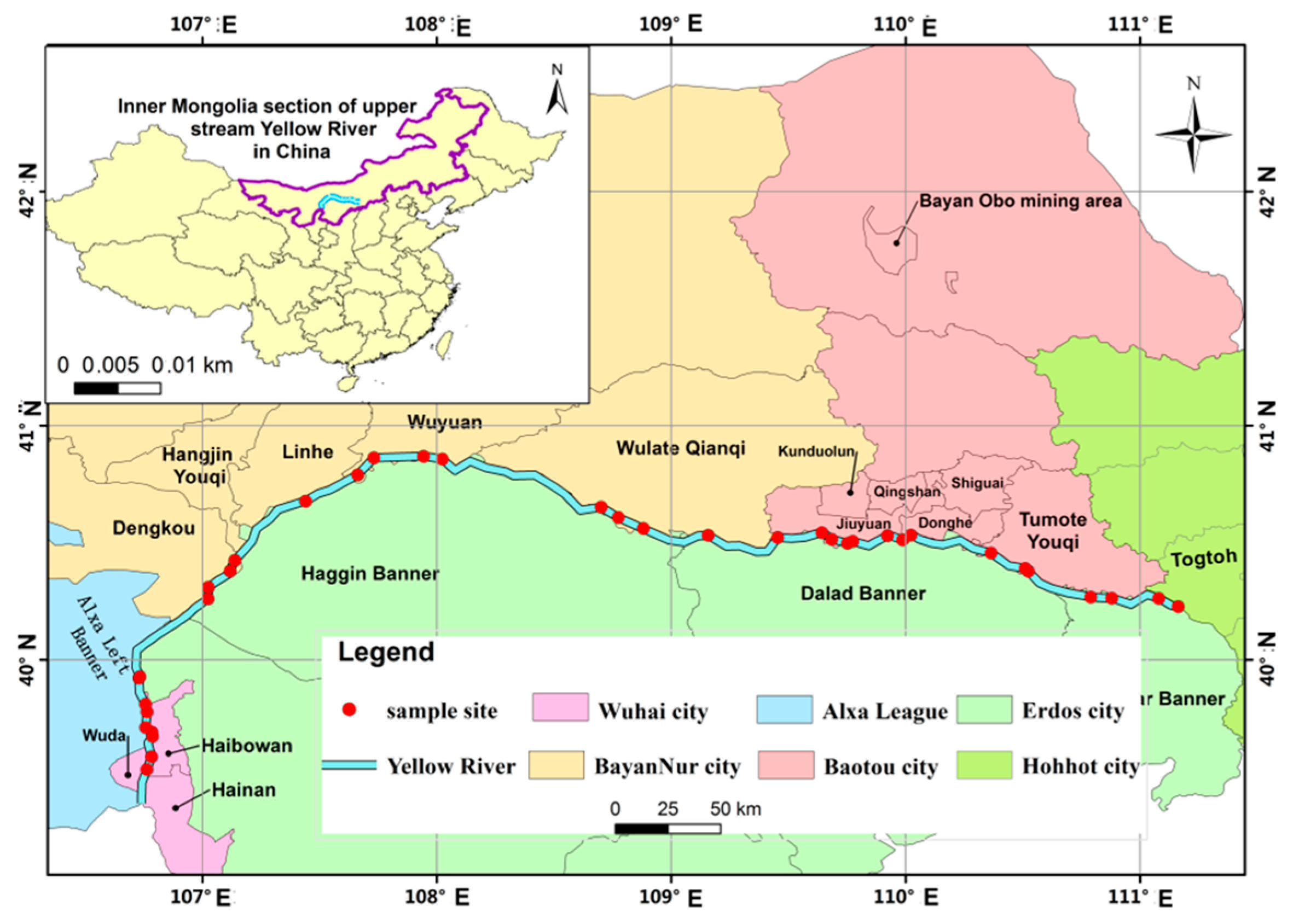
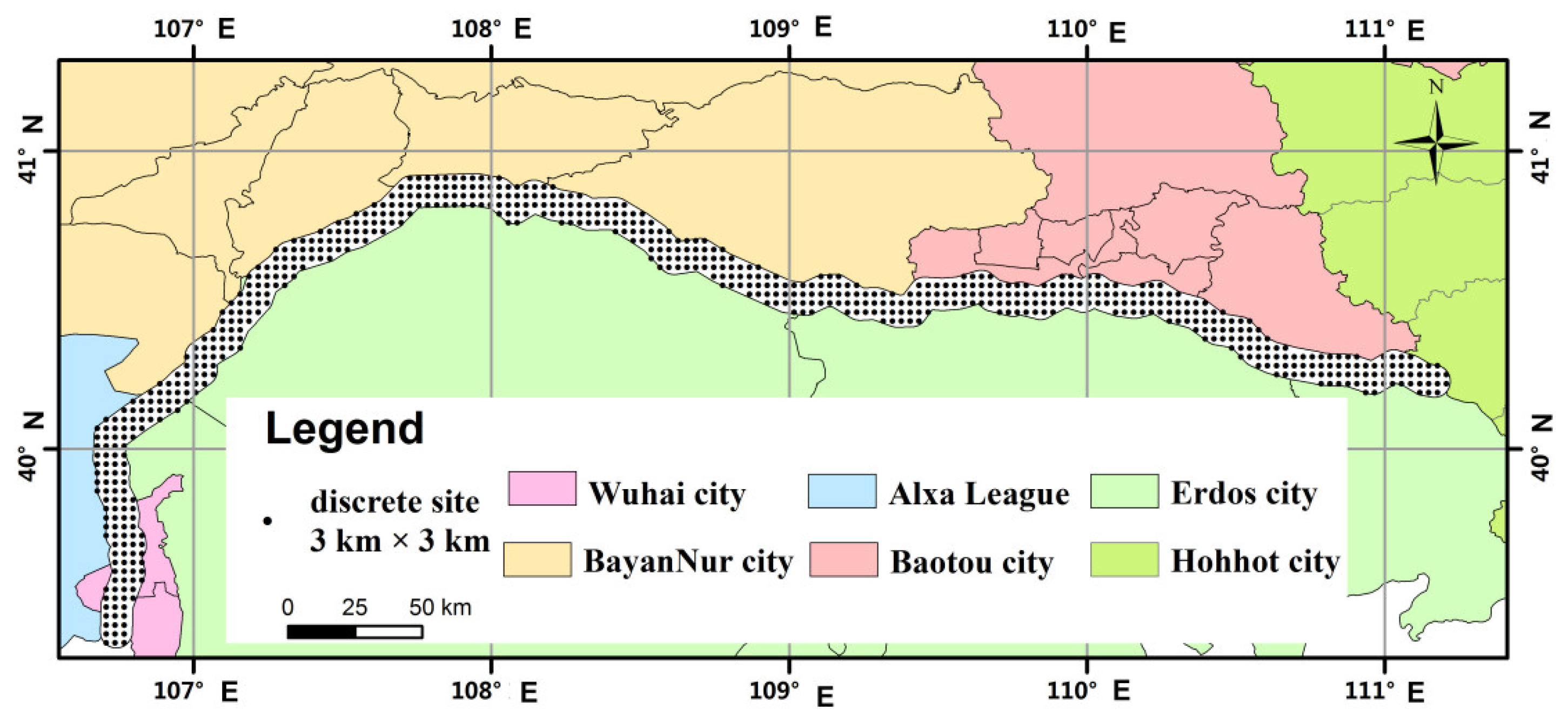
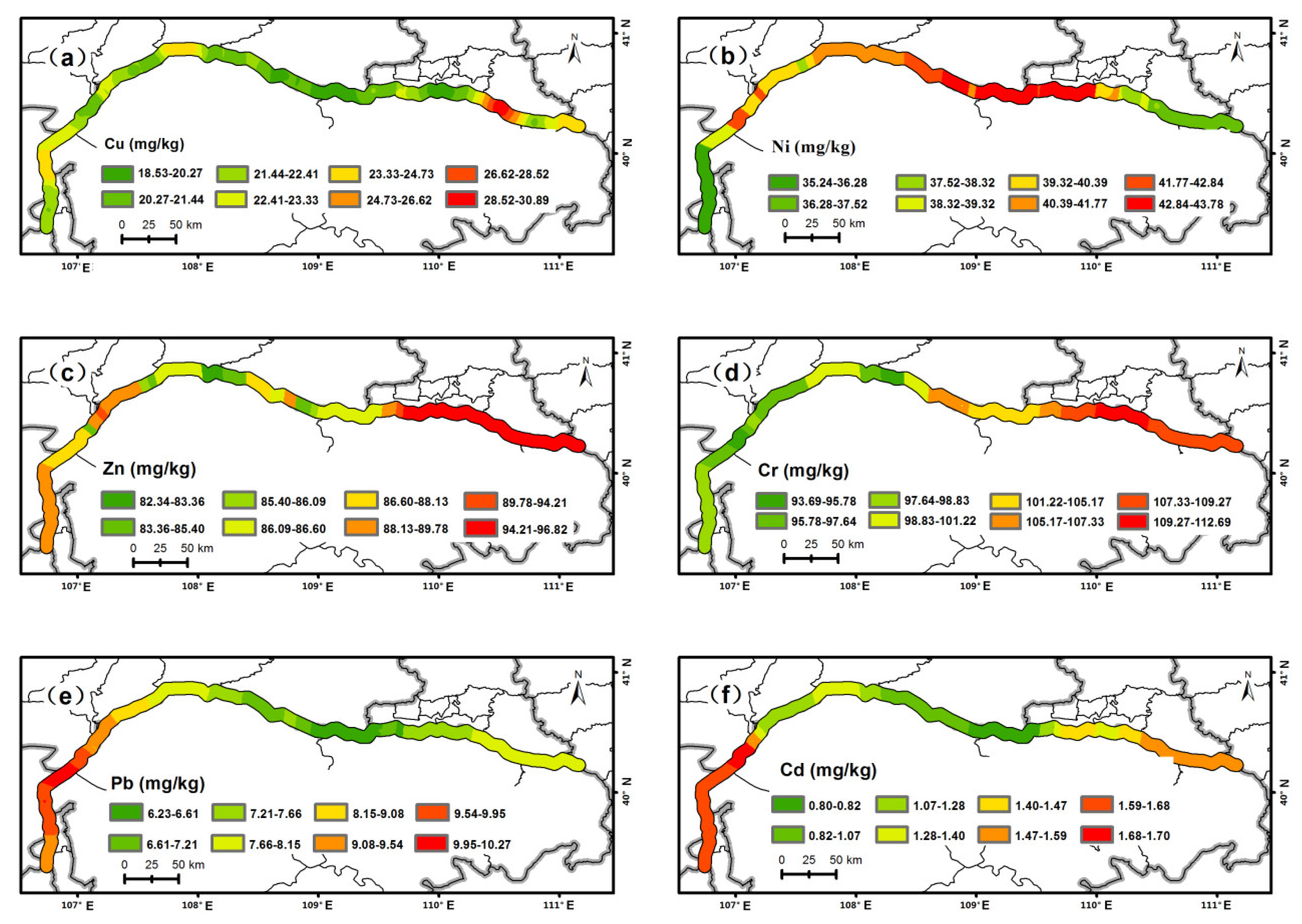
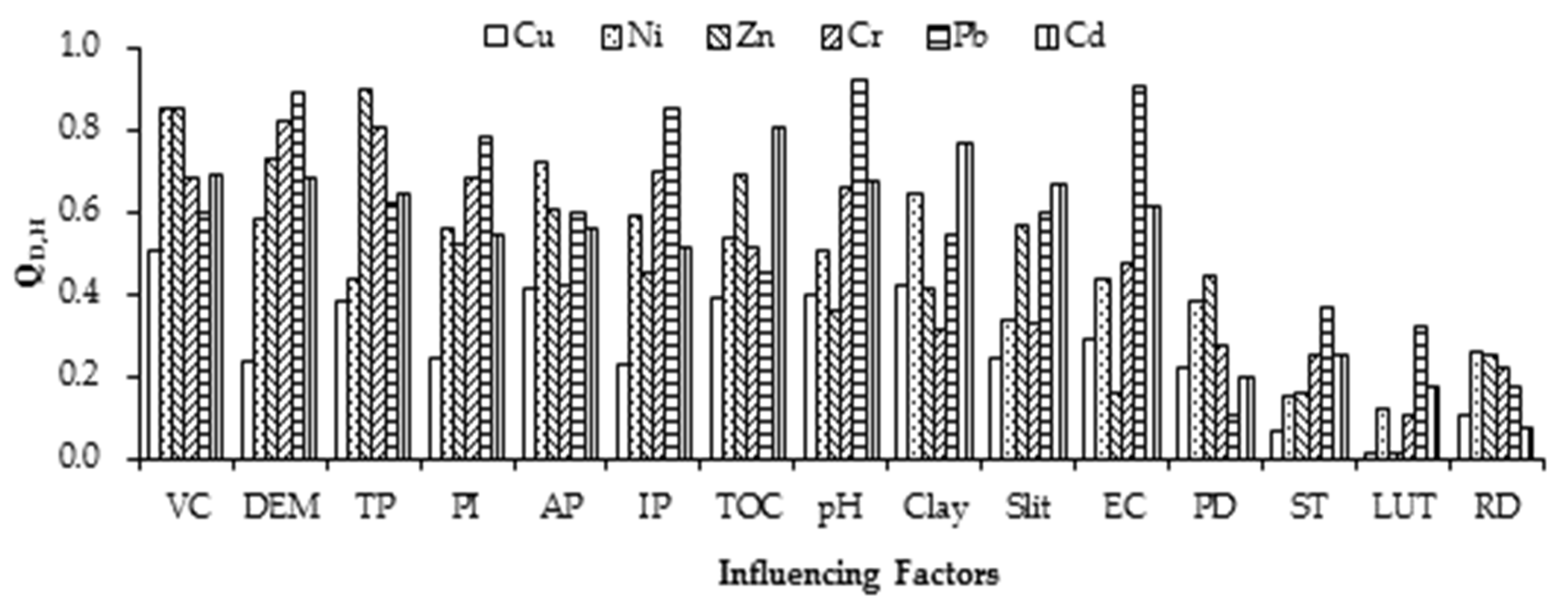
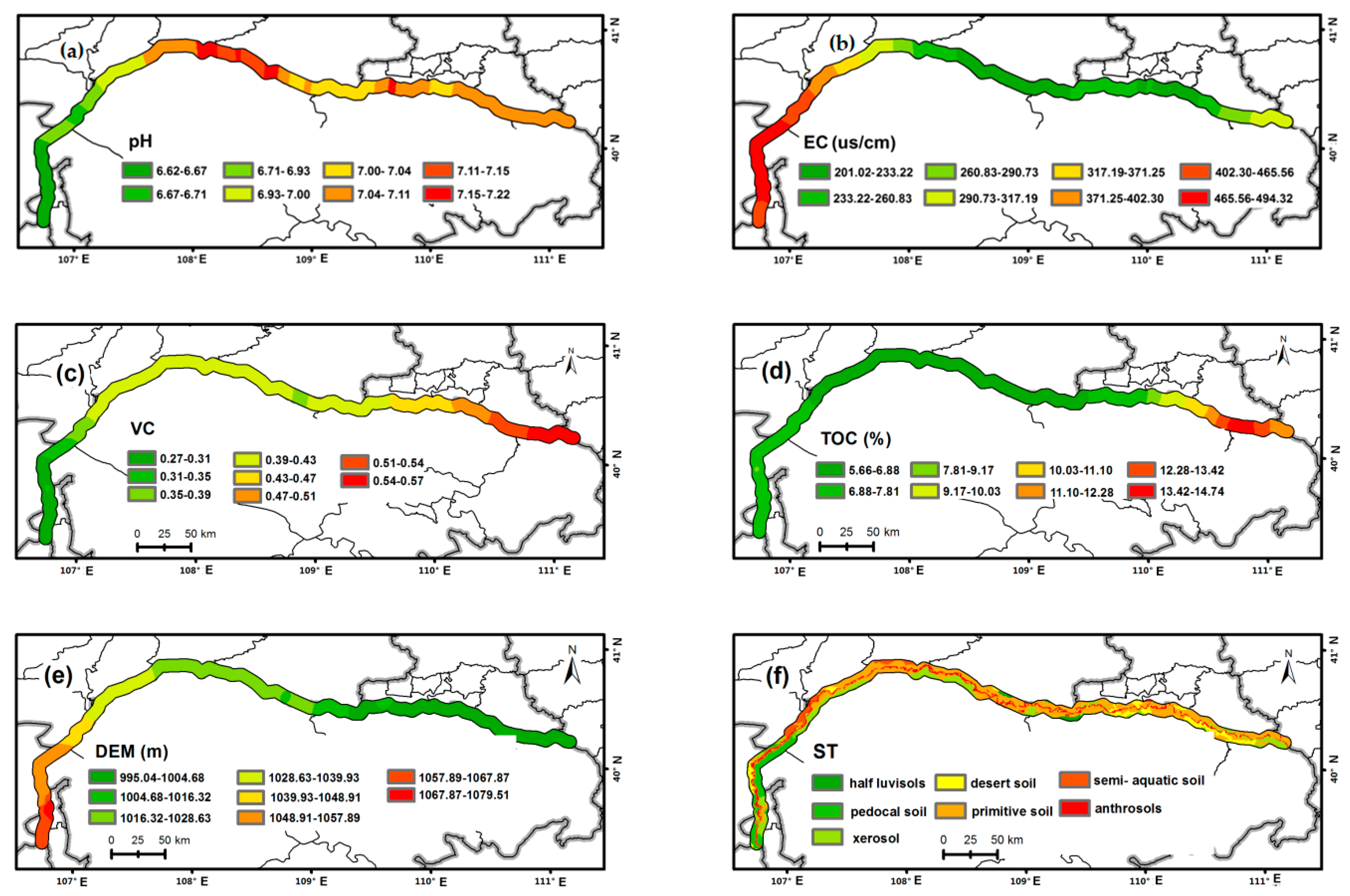
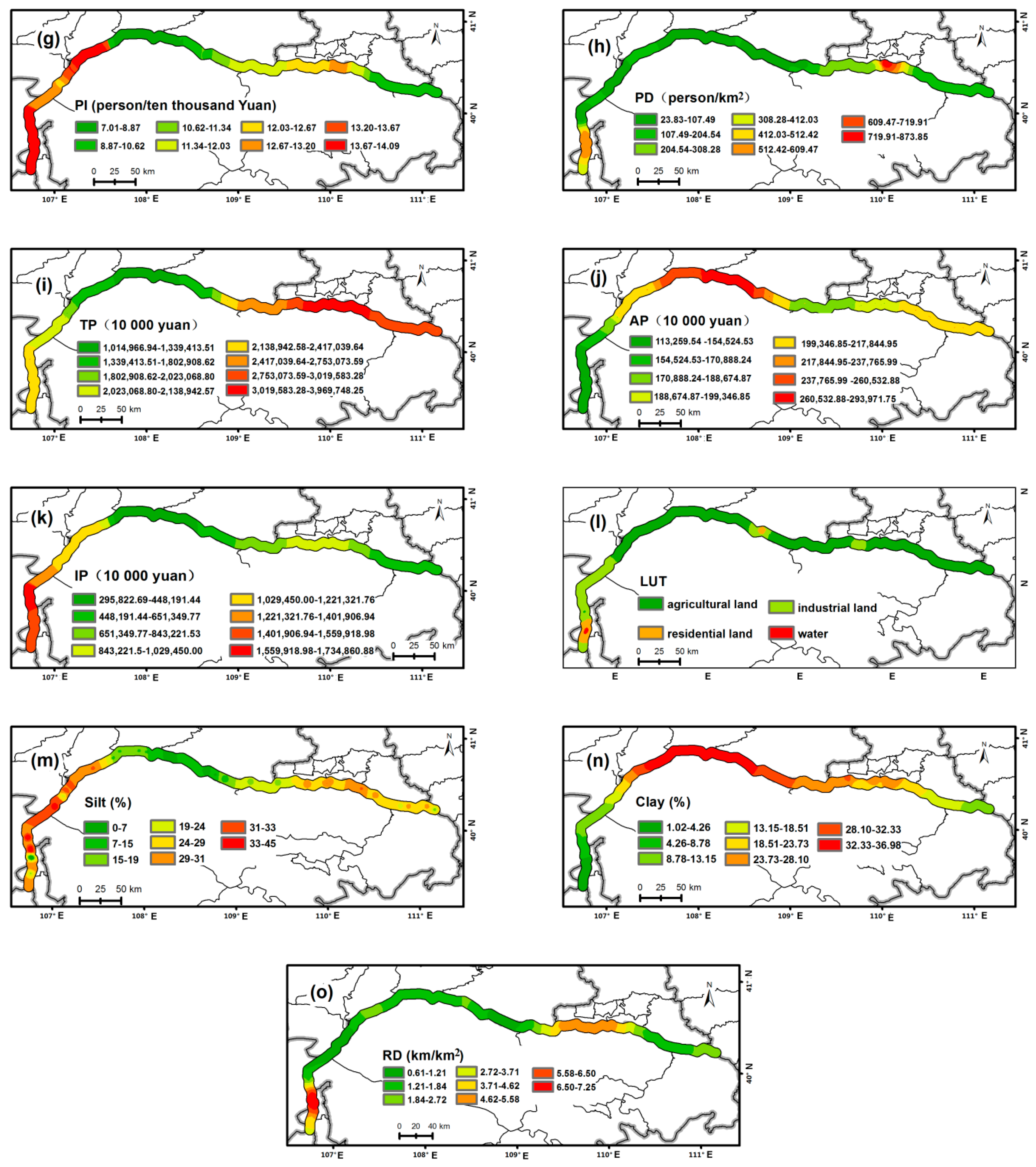
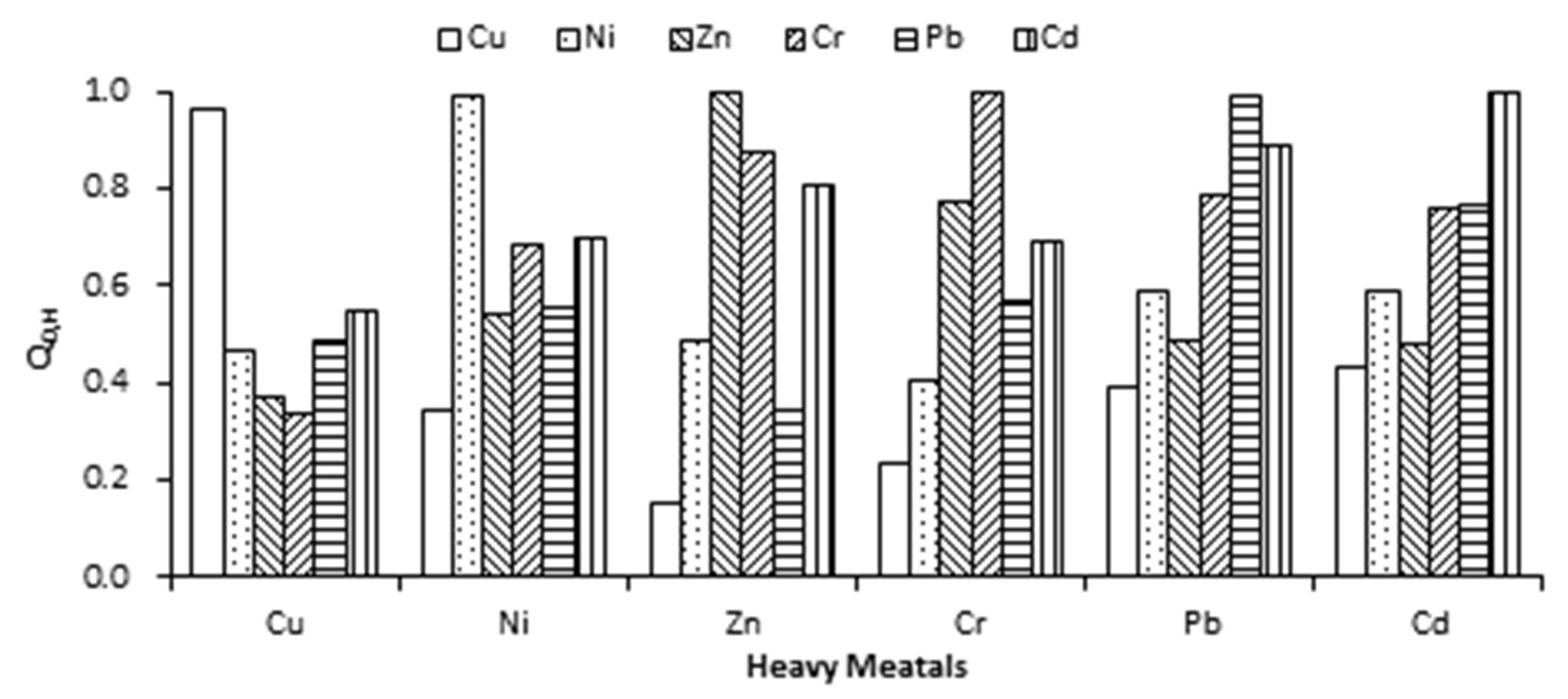
| Characteristic | Cu | Ni | Zn | Cr | Pb | Cd | References |
|---|---|---|---|---|---|---|---|
| Min | 10.28 | 8.52 | 60.93 | 65.69 | 0.50 | 0.23 | This study |
| Max | 45.54 | 67.39 | 149.40 | 149.67 | 19.98 | 4.36 | This study |
| Average | 22.47 | 38.89 | 89.70 | 101.87 | 8.16 | 1.38 | This study |
| SD | 7.45 | 14.83 | 19.89 | 21.95 | 3.93 | 1.13 | This study |
| CV (%) | 33.13 | 38.13 | 22.18 | 21.54 | 48.16 | 82.14 | This study |
| Average Value in Soil 1 | 17.42 | 31.91 | 142.30 | 40.53 | 7.45 | 1.21 | This study |
| World Average Concentration in Shales | 45 | 68 | 95 | 90 | 20 | 0.3 | Turekian and Wedepohl [39] |
| Grade I of Soil in China | 35 | 40 | 100 | 90 | 35 | 0.20 | The State Environmental Protection Administration (SEPA) [40] |
| Element | Explanatory Power Order | |||||
|---|---|---|---|---|---|---|
| 1 | 2 | 3 | 4 | 5 | ||
| Cu | Influencing Factor | VC | Clay | AP | pH | TOC |
| Value | 0.51 | 0.42 | 0.41 | 0.40 | 0.39 | |
| Risk Category | 8 | 3–4 | 5 | 6 | 7–8 | |
| Risk Area | Tumote | Dengkou; Tumote | Tumote | Tumote; Wuyuan | Tumote | |
| Ni | Influencing Factor | VC | AP | Clay | IP | DEM |
| Value | 0.86 | 0.73 | 0.65 | 0.59 | 0.59 | |
| Risk Category | 4–5 | 8 | 6 | 3–4 | 3 | |
| Risk Area | Byan Nur; Jiuyuan | Wulate; Wuyuan | Wulate; Jiuyuan | Wulate; Jiuyuan | Wulate | |
| Zn | Influencing Factor | TP | VC | DEM | TOC | AP |
| Value | 0.90 | 0.86 | 0.74 | 0.69 | 0.61 | |
| Risk Category | 8 | 6 | 1 | 7 | 3 | |
| Risk Area | Baotou | Donghe | Baotou | Tumote | Jiuyuan | |
| Cr | Influencing Factor | DEM | TP | IP | VC | PI |
| Value | 0.83 | 0.81 | 0.71 | 0.69 | 0.69 | |
| Risk Category | 1 | 8 | 3–4 | 6–7 | 5 | |
| Risk Area | Baotou | Baotou | Jiuyua; Donghe | Donghe; Tumote | Jiuyuan | |
| Pb | Influencing Factor | pH | EC | DEM | IP | PI |
| Value | 0.92 | 0.92 | 0.90 | 0.86 | 0.78 | |
| Risk Category | 1 | 8 | 7 | 7 | 8 | |
| Risk Area | Wuhai; Alxa | Wuhai; Alxa; Dengkou | Wuhai | Wuhai | Wuhai; Alxa; Linhe | |
| Cd | Influencing Factor | TOC | Clay | VC | DEM | pH |
| Value | 0.81 | 0.77 | 0.69 | 0.69 | 0.68 | |
| Risk Category | 5–6 | 1 | 1–2 | 7 | 1 | |
| Risk Area | Wulate | Wuhai | Wuhai; Alxa | Wuhai | Wuhai; Alxa | |
| Interaction Level | Q (D1 ∩ D2) | Q (D1) + Q(D2) | Interaction Type | |
|---|---|---|---|---|
| Cu | first | AP ∩ EC (0.8886) | 0.4116 + 0.3928 = 0.8044 | enhancement of nonlinearity |
| second | AP ∩ VC (0.8250) | 0.4116 + 0.5058 = 0.9174 | enhancement of two factors | |
| Ni | first | VC ∩ pH (0.9720) | 0.8603 + 0.5127 = 1.3730 | enhancement of two factors |
| second | VC ∩ AP (0.9633) | 0.8603 + 0.7282 = 1.5885 | enhancement of two factors | |
| Zn | first | TP ∩ pH (0.9845) | 0.9030 + 0.3626 = 1.2656 | enhancement of two factors |
| second | TP ∩ VC (0.9562) | 0.9030 + 0.8591 = 1.7621 | enhancement of two factors | |
| Cr | first | IP ∩ pH (0.9968) | 0.7066 + 0.6643 = 1.3709 | enhancement of two factors |
| second | TP ∩ pH (0.9847) | 0.8090 + 0.6643 = 1.4733 | enhancement of two factors | |
| Pb | first | IP ∩ pH (0.9872) | 0.8551 + 0.9240 = 1.7791 | enhancement of two factors |
| second | IP ∩ PI (0.9815) | 0.8551 + 0.7844 = 1.6395 | enhancement of two factors | |
| Cd | first | TP ∩ pH (0.9987) | 0.6458 + 0.6819 = 1.3277 | enhancement of two factors |
| second | TP ∩ PI (0.9915) | 0.6456 + 0.5452 = 1.1908 | enhancement of two factors | |
Publisher’s Note: MDPI stays neutral with regard to jurisdictional claims in published maps and institutional affiliations. |
© 2021 by the authors. Licensee MDPI, Basel, Switzerland. This article is an open access article distributed under the terms and conditions of the Creative Commons Attribution (CC BY) license (https://creativecommons.org/licenses/by/4.0/).
Share and Cite
Hao, J.; Ren, J.; Fang, H.; Tao, L. Identification Sources and High-Risk Areas of Sediment Heavy Metals in the Yellow River by Geographical Detector Method. Water 2021, 13, 1103. https://doi.org/10.3390/w13081103
Hao J, Ren J, Fang H, Tao L. Identification Sources and High-Risk Areas of Sediment Heavy Metals in the Yellow River by Geographical Detector Method. Water. 2021; 13(8):1103. https://doi.org/10.3390/w13081103
Chicago/Turabian StyleHao, Jianxiu, Jun Ren, Hongbing Fang, and Ling Tao. 2021. "Identification Sources and High-Risk Areas of Sediment Heavy Metals in the Yellow River by Geographical Detector Method" Water 13, no. 8: 1103. https://doi.org/10.3390/w13081103






